
Newsletter of the Shell Club of Sydney
NSW Branch, The Malacological Society of Australasia Limited ACN 067 894 848
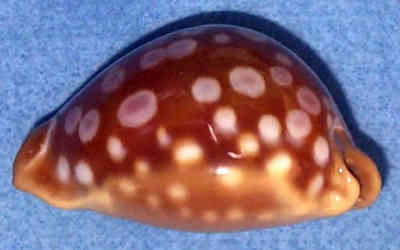
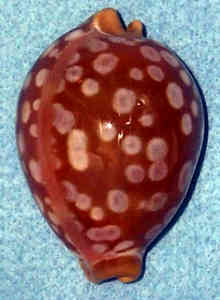
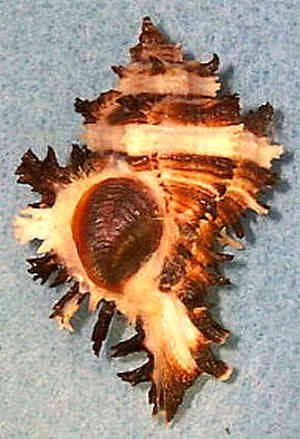
Cypraea leucodon, Balute Is. Courtesy Neptune Shells
Hexaplex cichoreum, Cebu Courtesy Neptune Shells - the photo is not reversed
SCALLOP SEASON NOW OPEN IN TASMANIA
By Des Beechey
There are three types of scallops fished commercially in Tasmania. The queen scallop
(Pecten bifrons), the doughboy scallop (Pecten
asperrimus) and the commercial scallop (Pecten
meridionalis). The most important one in Tasmania is the commercial scallop. The doughboy scallop is more commonly taken in Victoria, and the queen scallop is South Australia.
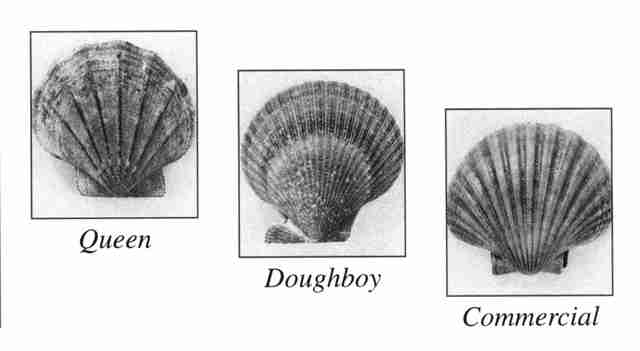
Scallops are taken by dredge - a dredge about two metres wide is towed behind a boat. The dredge pulls up a lot of other things apart from scallops, and destroys a lot of living things on the seabed. The best scallop areas in Tasmania, around the mouth of the Derwent River at Hobart were fished out long ago, and have to be given period closed periods for stocks to recover.
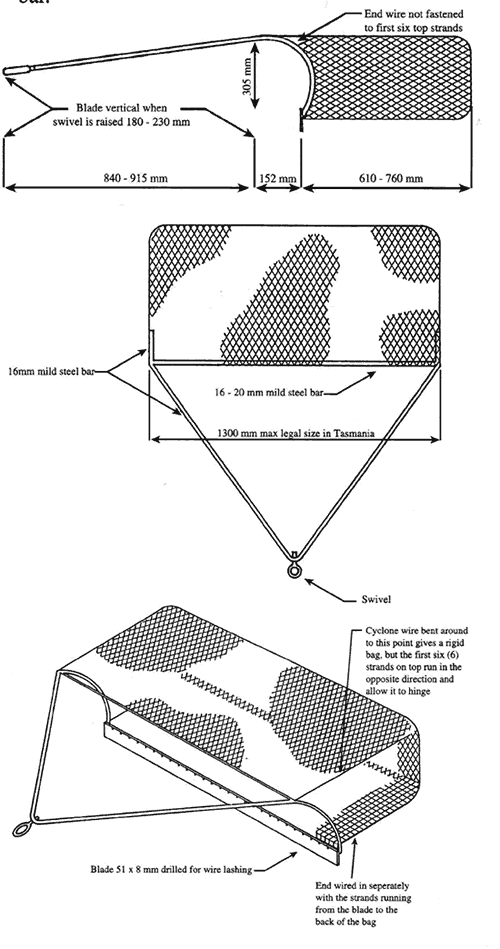
Recreational scallop dredging is allowed in Tasmania. The season is open from 15 June 99 to 30 October 99. You have to apply for a licence, and you are limited to a take of 100 per day. There is a minimum legal size set; 100 mm for queen, 80 mm for commercial and doughboy.
Does anyone know where the common name of 'doughboy' for Pecten asperrimus came from?
Mollusc auctions
In Our August meeting we had two unexpected visitors from USA. Bret Raines (see picture) and Kim Hutsell. They had been in Australia on a field trip off the Queensland coast, with about 20 other people from around the world, including two from our club.
Kim is a field researcher in marine malacology based out of San Diego. He was impressed with our Sydney Sheller and has become a member so he can receive copies.
Bret collects Pectinidae. He describes himself as a "pecten nut". While in the military, he was stationed at or travelled to Alaska, Australia, Florida, Guam, Hawaii, Japan, Korea, Okinawa, Philippines and Truk. He is currently an environmental project manager for the US federal government and lives in a 'one horse' town in the desert, not so good for shell collecting.

Bret runs an on line shell auction on his comprehensive web site. http://www.molluscs.net
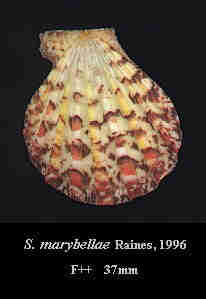
The web site also includes a chat forum, answering questions. A couple of recent questions were about cleaning and preserving echinoderms. The answers recommend bleach diluted to 10% of household strength for a short time if removing spines. No longer than 15min - 1hr to avoid the plates separating. Then strengthen the shell without changing its appearance by soaking it in glue (Elmers Glue or Sobo glue diluted with water - 10% for sand dollars, 20-25% for urchins, then allowing to dry on a non-stick surface such as grease paper. Full strength glue can be used inside)
I wonder what Ashley our resident echinoderm expert would say about the glue?
Cymatium armatum (Sowerby, 1897) July 1999
By Vincent CRAYSSAC
 
October the 20th, 1996, another specimen of C. armatum was found, live, near Noumea. So far, about ten specimens have been found in various localities situated from North Queensland, Australia up to Vanuatu. From that recent finding, we can now add New Caledonia as a new range extension of that very rare specie of Cymatium.
Very little is known actually about that species, due to the very low number of specimens found so far. However, from that new New-Caledonian specimen, which measures 82.7mm in length, its general description can be determined as follows:
General brownish orange background colour, with some paler areas and some almost whitish nodules on the varices situated on the last whorl. We can also notice, numerous varices crossed by ribs. The siphonal canal is twisted, the columella streaked with dark brown. There are sixteen whitish folds and the outer lip has eleven. The edge is sculptured with 6 digitations.
The 2 specimens collected in New-Caledonia so far, have been found in very shallow water, 1m - 3m, in muddy/sandy bottoms. Apparently specimens have been found both in the south west, near Noumea and in the north east, near Ballade, Maat bay which would tend to suggest that we may find that superb rarity everywhere around New-Caledonia.
Gourmya gourmyi
(Crosse, 1861) August 1999
By Vincent CRAYSSAC

First of all, from the study of the radula and operculum by Houbrick, 1981, we can include Gourmya as a valid genus in the family Cerithiidae.
Gourmya gourmyi is a rare, relatively large, and very distinctive prosobranch that lives subtidally from 5m up to 30m on rocky substrata associated with coral reefs drop-offs. Living animals are collected clinging tightly to algae-covered rocky surface along high-energy reef slopes. We can find it only in a restricted part of the southwest pacific. More precisely around New-Caledonia up to Chesterfields Islands.
The shell is still largely ignored by both collectors and scientists, as very few specimens are represented in museums or in the collections in general.
The unusual, centrally placed anterior siphonal canal and the large ovate aperture with hooklike extension of the outer lip over the siphonal canal allow the shell to withdraw its head and clampdown on the rock without any gaps
between the aperture edge and the foot. Communication with the external environment is maintained via the siphonal canal by means of the siphonal ocelli and sensory receptors of the siphonal mantle edge. The thickened varix along the outer lip served to strengthen the body whorl and protects the snail from crushing predators.
Stomach anatomy and contents studied, plus the radular ribbon, suggest that Gourmya is a grazer of coarse algal substrates. Nothing is known of its reproductive biology, spawn or larvae.
Most Cerithiids live in subtidal or intertidal shallow water environments where they have undergone extensive adaptive radiations into sandy limons, grass beds and the rocky intertidal. The environmental niche of Gourmya, high-energy outer reef drop-offs, is unusual and may explain why the group never became as geographically widespread as other Cerithiids. In terms of species numbers, and compared to the other large Cerithiid groups, the genus was not a successful group.
|










